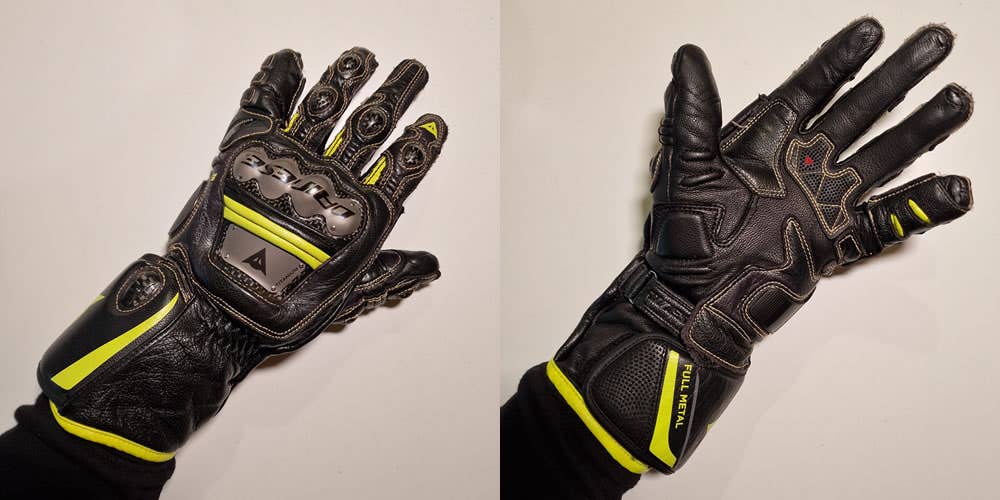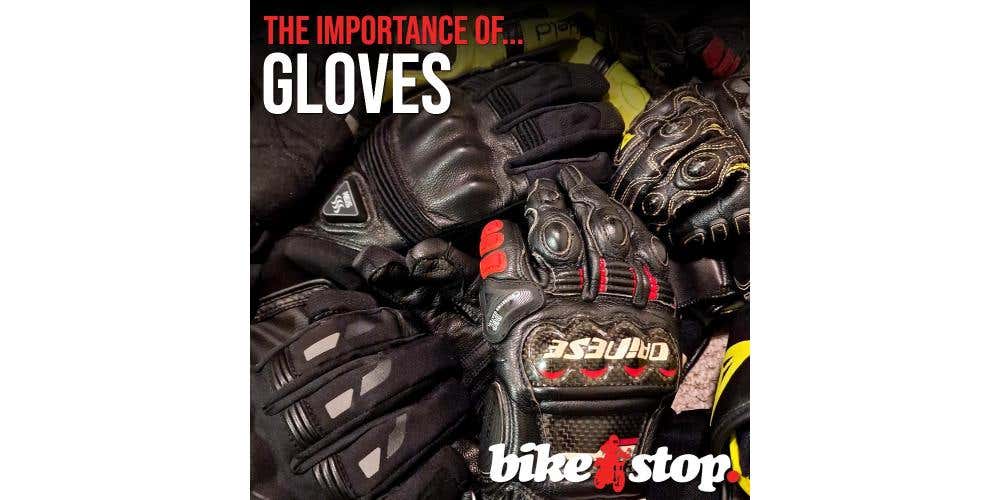We're looking at gloves for part three of our "importance of..." series. Gloves are one of the most critical items in your protective arsenal and for good reasons. Typically, when you're punted off your bike by an inattentive Transit driver or by enthusiastic misadventure, your hands are the first part of your body to hit the ground. As you fly through the air, your natural reaction when landing is to put your hands out to break your fall. We might think we'd be able to overcome this instinct, but it's hard to control the reflex in the heat of the moment. However, not all motorcycle accidents involve flying through the air. Many of them involve sliding across the ground. If you're lucky, the ground in question is damp grass and soft mud, but more often than not, it's harsh, abrasive and unforgiving tarmac or concrete. Again, overcoming the reflexive urge to put our hands out to slow us down or stop rolling is tough. Given that it's hard for us to control what we do with our hands and how easily they're damaged, it's best to protect them as well as we can.
Additionally, a good pair of gloves don't just protect you from the trauma of an accident. Grip and vibration dampening are also important properties. The grip should be an obvious one, as I'm sure we all like to be able to use our throttles and operate our clutches and front brakes. Dampening vibrations is an often overlooked property of motorcycle gloves. Even the smoothest motorcycles produce vibrations through the bars, and if you were to be subject to those vibrations with bare hands, you'd quickly find your hands going numb. Even with the best pair of gloves, numbness will creep in over a long enough time, but gloves mitigate the effect allowing you to ride in comfort for longer. Furthermore, we shouldn't ignore the ability of gloves to keep our hands warm and dry when riding conditions are less than ideal.
Protection
Palms, knuckles, fingers and wrists. Those are the important bits we need to protect, and also happen to be every part of the hand, excluding the back. The reason we're not too concerned about the back of the hand is that it's incredibly rare for it to come into contact with the ground. Typically, the knuckle protection protrudes enough to stop the back of the hand from sliding across the ground whilst also providing enough impact protection to protect the metacarpal bones.
Palms: Protecting the palms is more about abrasion resistance than handling impact. Your palms are the bits most likely to take a beating when you're sliding along the ground and trying to slow yourself down. Decent palm protection comes in the form of hard-wearing leather, usually backed with some form of aramid, such as Kevlar. The palm of the glove also needs to provide a suitable grip for operating the throttle and for holding on to the grips comfortably.
Knuckles: One defining feature of motorcycle gloves is knuckle protection. Contrary to some peoples' beliefs, it doesn't exist purely to punch wing mirrors off badly-driven cars. It's there to protect against one of the most hideous types of hand injuries. The armour around the knuckles is likely to be the bulkiest and most significant part of the glove, as it has to fulfil the functions of both protecting the knuckles from impact and allowing them to slide along the ground. Furthermore, it needs to perform both of those functions whilst allowing a free range of movement for the fingers. It's common to see knuckle protection in many materials, ranging from soft plastics to carbon fibre and aluminium to titanium.
Fingers: It doesn't take much force to break a finger. Jack Bauer taught me that. Furthermore, once a finger breaks, you can't guarantee it'll be the same after it's healed, and it may never regain its full range of motion. As with many other components of motorcycle gear, we want to ensure things slide rather than dig in. Sliding goes a long way to stop our fingers from twisting and breaking. If you take look at the Dainese Full Metal 6 glove below, you'll notice that the joints on the fingers are covered with little rounded pucks of carbon fibre. Those little pucks offer impact protection and help the backs of our hands slide along the ground. While not all gloves will have fancy carbon fibre protection, any decent pair will have suitable reinforcement and padding.
Wrists: It should go without saying that it's important to protect your wrists. Mostly because your wrist is the bit that connects your hand to your body. Between the metacarpal bones, which mark the start of your fingers, and the ulna and radius bones of your forearm is a collection of eight little bones you don't want to damage. Look for gloves with good wrist protection. While short gloves may feel better in summer, they can be lacking when it comes to protecting your wrists. Longer, gauntlet-style gloves offer better protection for your wrists.
Fit, feel and comfort
Fit and feel is also an important part of choosing the right glove. Similar to helmets, different brands and different models will suit different hands. When you're trying out new gloves, try to make sure your fingers and thumbs fill the holes completely and there's no excess flapping around. You'll need to make the glove is comfortable with both a relaxed, open hand and with a clenched fist, to ensure you have comfort through a full range of motion. Remember, most of the time your gloved hand is going to be in a clenched position as it's wrapped around your throttle. Unsurprisingly, the gloves should... fit like a glove.
The wrist strap, which is almost always a velcro fastening, should be tight enough so that the glove cannot be pulled from your hand. However, you shouldn't pull it so tight that you're strangling your wrist, as you're going to restrict the flow of blood and end up with numb hands pretty quickly.
Similarly, the wrist cuff should be tight enough to create a comfortable seal around your sleeves.


Standards
Motorcycle gloves should be certified to the EN13594 standard.
On a label inside your gloves, you should find the certification information. On the label, there's the little pictogram of the bike enjoying his Sunday ride (although his bike appears to be lacking a frame and engine), as well as two detail boxes and the standard designation.
There are five mandatory and one optional test for gloves.
Cuff Length: For a Level 1 pass, the measure from the wrist to the end of the cuff must be at least 15mm. A Level 2 pass requires a minimum length of 50mm.
Restraint: The mechanism which keeps the glove on your hand. This is typically the velcro strap around the wrist. A machine attempts to lift the glove off a dummy for 30 seconds. If it takes 52N of force to remove the glove from the hand, it gains a Level 2 pass. If it requires 27N of force to remove the gloves, it gets a Level 1. Anything less is a failure.
Tear Strength: As with the other tear strength tests, a machine attempts to pull apart three samples of the glove's materials. For a Level 1 pass, the palm and palm-side of the fingers must withstand 25N of force and the cuff, back of the hand, fourchettes and back of fingers must withstand 18N. For a Level 2 pass, the palm and palm-side of fingers must withstand 35N, the fourchettes 25N and 30N for the cuff, back of hand and side of fingers.
Seam Strength: A machine attempts to pull apart the seams of the gloves. A Level 1 pass requires 6Nmm for the main seams and 4Nmm for the fourchettes. For Level 2, those numbers increase to 10Nmm and 7Nmm, respectively.
Impact Abrasion: Similar to the Impact Abrasion test highlighted above, the gloves are dropped onto a moving abrasive belt. A Level 1 pass means no holing below 4 seconds, with a Level 2 pass requiring no holing below 6 seconds.
Impact Protection for Knuckles: This is an optional test and is indicated by a 'KP' designation in the information panel. A Level 1 pass means a single strike cannot transmit more than 9kN of force, and the mean force across all samples can't exceed 7kN. For Level 2, those numbers decrease to 4kN for both a single strike and the average.


There's a lot to the world of motorcycle gloves. They come in different lengths, styles, colours and themes. Some are suited for the hottest days in summer, some for the coldest nights in winter. They can be made of cow leather, kangaroo leather, goat leather, aramids, Gore-Tex or textiles. They can feature plastic, aluminium, carbon fiber and titanium. They can be heated, insulated, waterproof and ventilated. Whatever option you choose, just make sure you're getting the best level of protection for your budget. The team at Bike Stop are always available to help in choosing your next glove.
Don't ever ride without gloves. If things go wrong it can be a painful and permanent price to pay.






